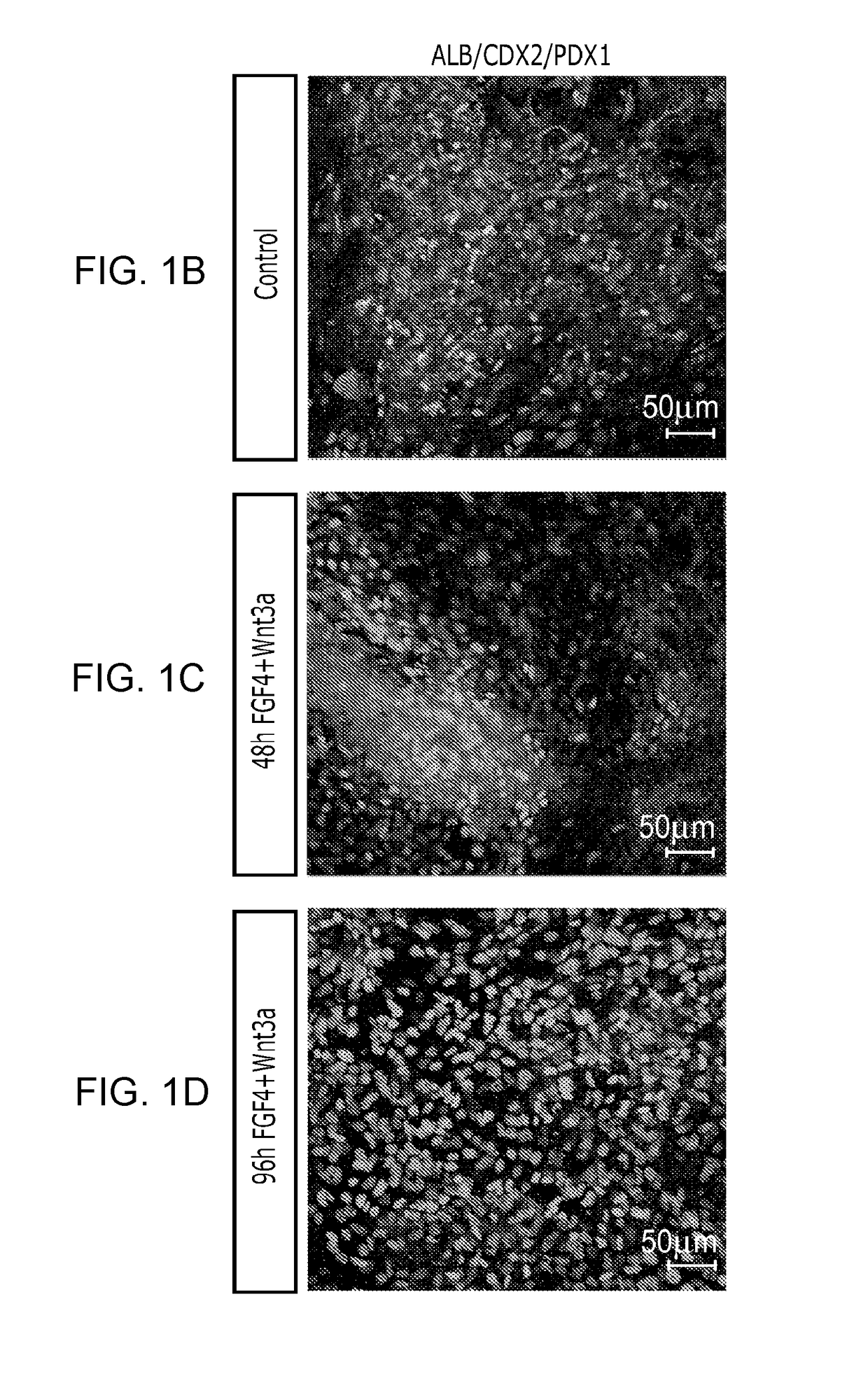Methods and systems for converting precursor cells into intestinal tissues through directed differentiation
a technology of directed differentiation and precursor cells, which is applied in the field of directed differentiation of precursor cells into intestinal tissues, can solve the problem that pluripotent stem cells alone cannot develop into and achieve the effect of reducing the number of fetal or adult animals
- Summary
- Abstract
- Description
- Claims
- Application Information
AI Technical Summary
Benefits of technology
Problems solved by technology
Method used
Image
Examples
example 1
Directing Hindgut Development of PSCs
[0134]Maintenance of PSCs.
[0135]Human embryonic stem cells and induced pluripotent stem cells were maintained on Matrigel (BD Biosciences) in mTesR1 media. Cells were passaged approximately every 5 days, depending on colony density. To passage PSCs, they were washed with DMEM / F12 media (no serum)(Invitrogen) and incubated in DMEM / F12 with 1 mg / mL dispase (Invitrogen) until colony edges started to detach from the dish. The dish was then washed 3 times with DMEM / F12 media. After the final wash, DMEM / F12 was replaced with mTesR1. Colonies were scraped off of the dish with a cell scraper and gently triturated into small clumps and passaged onto fresh Matrigel-coated plates.
[0136]Differentiation of PSCs into Definitive Endoderm (DE).
[0137]Differentiation into Definitive Endoderm was Carried Out as Previously Described.
[0138]Briefly, a 3 day ActivinA (R&D systems) differentiation protocol was used. Cells were treated with ActivinA (100 ng / ml) for three...
example 2
Directing Hindgut Spheroids into Intestinal Tissue In Vitro
[0152]Directed Differentiation into Hindgut and Intestinal Organoids.
[0153]After differentiation into definitive endoderm, cells were incubated in 2% dFBS-DMEM / F12 with either 50 or 500 ng / ml FGF4 and / or 50 or 500 ng / ml Wnt3a (R&D Systems) for 2-4 days. After 2 days with treatment of growth factors, 3-dimensional floating spheroids were present in the culture. 3-dimensional spheroids were transferred into an in vitro system previously described to support intestinal growth and differentiation. Briefly, spheroids were embedded in Matrigel (BD Bioscience #356237) containing 500 ng / ml R-Spondin1 (R&D Systems), 100 ng / ml Noggin (R&D Systems) and 50 ng / ml EGF (R&D Systems). After the Matrigel solidified, media (Advanced DMEM / F12 (Invitrogen) supplemented with L-Glutamine, 10 μM Hepes, N2 supplement (R&D Systems), B27 supplement (Invitrogen), and Pen / Strep containing growth factors was overlaid and replaced every 4 days.
[0154]Dire...
example 3
Cytodifferentiation of PSCs into Mature Intestinal Cell Types
[0165]Between 18 and 28 days in vitro, it was observed that cytodifferentiation of the stratified epithelium into a columnar epithelium containing brush borders and all of the major cell lineages of the gut as determined by immunofluorescence and RT-qPCR (FIG. 4 and FIG. 11). By 28 days of culture Villin (FIG. 4a, a′) and DPPIV were localized to the apical surface of the polarized columnar epithelium and transmission electron microscopy revealed a brush border of apical microvilli indistinguishable from those found in mature intestine (FIG. 4d and FIG. 5). Cell counting revealed that the epithelium contained approximately 15% MUC2+ goblet cells (FIGS. 4a, a′), which secrete mucin into the lumen of the organoid (FIG. 11e), 18% lysozyme positive cells that are indicative of Paneth cells (FIG. 4b, b′) and about 1% chromogranin A-expressing enteroendocrine cells (FIG. 4c, c′; and FIG. 11). RT-qPCR confirmed presence of additio...
PUM
 Login to View More
Login to View More Abstract
Description
Claims
Application Information
 Login to View More
Login to View More - R&D
- Intellectual Property
- Life Sciences
- Materials
- Tech Scout
- Unparalleled Data Quality
- Higher Quality Content
- 60% Fewer Hallucinations
Browse by: Latest US Patents, China's latest patents, Technical Efficacy Thesaurus, Application Domain, Technology Topic, Popular Technical Reports.
© 2025 PatSnap. All rights reserved.Legal|Privacy policy|Modern Slavery Act Transparency Statement|Sitemap|About US| Contact US: help@patsnap.com



